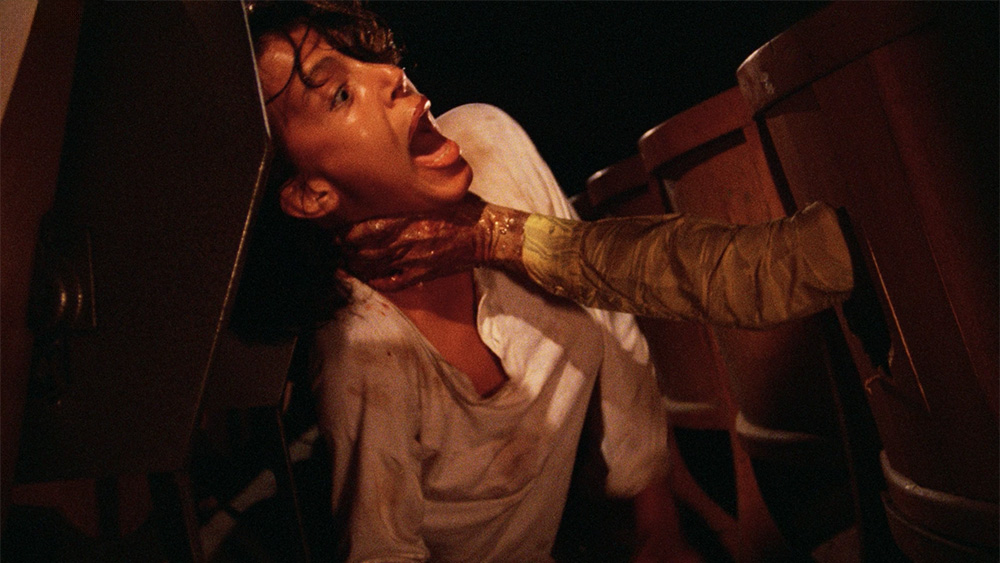There’s an inherent element of trust built into going to the cinema. We trust the filmmakers to produce a worthwhile film, we trust the projectionist to put on a seamless show, and we trust our fellow patrons to be respectful for the duration of the experience. Willingly putting ourselves into a dark auditorium, surrounded by dozens, if not hundreds, of strangers is an integral aspect of being a cinephile, yet it’s rife with the potential for hazards. Bigas Lunas’s metatextual nightmare Anguish (1987) understands and comments on the relationship between cinema patrons and the dark rooms they inhabit. Lamberto Bava, with his 1985 Dario Argento-produced splatter-fest, Demons, offers a similarly metatextual horror show, but with an intriguing and more insidious prompt: What if our fellow patrons weren’t the only source of potential violence, but the screen itself was?
The simple narrative crux of Bava’s Demons, which was co-written by Argento, revolves around a group of young people who are offered admission to a secret movie screening. It turns out that the film they are unsuspectingly the audience for is a gruesome horror film about Nostradamus’s Prophecies. As the film they are watching grows increasingly violent, members of the audience begin to die and/or turn into demons. A palpably gross amalgam of body horror, supernatural terror, and Anguish-esque cinema panic, Bava’s film is a cocktail of inspirations, obsessions, and transgressions tethered to an admiration for the communal experience of going to the movies.
The first third of Demons feels like a love letter to cinephilia, a sort of a Cinema Paradiso (1988) for wayward souls. Despite the fact that the ensemble of characters is not planning to see a film near the beginning of Demons, they prove all too willing to surrender themselves to the experience. The environs and screen of Metropol, the cinema in the film, bring to mind the many movie palaces lost to time or, in the era of Demons’s release, turned into revival houses or grindhouses that always looked like they were in a state of disrepair. Bava juxtaposes the ornate maximalism of the theater’s decor with the inherent cheapness of the images thrust on Metropol’s screen—stock images of young coeds being chased through a cemetery before being stabbed to death.
The bulk of Bava’s film sees his leads fend off demons—the possessed souls of their fellow audience members—in exceedingly gory ways. About halfway through the film, a newly eyeless man announces: “It’s this theater that kills.” This renders explicit that the ultimate antagonist in Demons isn’t its titular monsters, but the space the audience inhabits. And so, Bava’s film, despite its reliance on shock horror and gruesome excesses—sex worker caricatures and a man who snorts cocaine through a straw inserted into his soda can—has more in common with the metatextual and philosophically insightful Anguish than would appear at face value.
Demons isn’t just a gory horror movie set in a movie theater, it’s a film that wrestles with its very existence. Bava understands, as well as anyone, the effect of the cinema and the relationship between audiences and horror films. After all, he grew up as the son of gothic horror and giallo luminary Mario Bava. His film is simultaneously a tribute to the films of his father and his contemporaries, including an of-the-moment commentary on the heightened awareness of violence in horror movies that was responding to the Video Nasties scandal that took place in the UK the year before the release of Demons. Bava comments on this by way of samurai sword-wielding demon slayers, projectile bodily fluids, and enough cocaine to jump-start a theater full of corpses, but subtlety was hardly his, or his peers, forte. This is a film, and filmmaker, who knows full well who his audience is, someone who is not only willing to mirror them on-screen, but show just how vulnerable audiences ultimately are. It’s his theater that kills.
Demons screens on 35mm on Wednesday, July 30 at the Balboa Theater, presented by 35 Milli-Murder.
Previously:
Demons screens tonight, September 3, at Alamo Drafthouse Downtown Brooklyn in 35mm as part of “Terror Tuesdays.”



